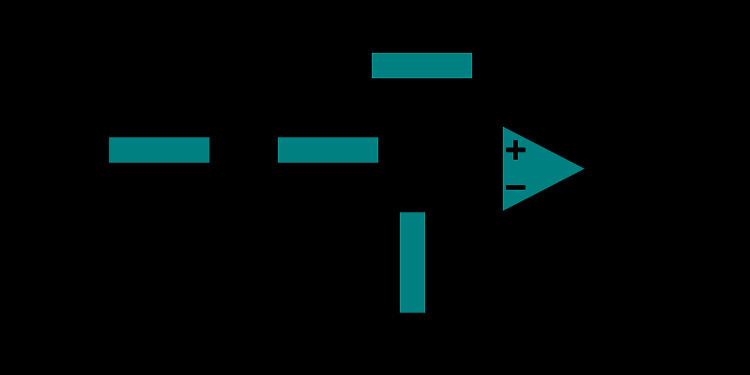 | ||
The Sallen–Key topology is an electronic filter topology used to implement second-order active filters that is particularly valued for its simplicity. It is a degenerate form of a voltage-controlled voltage-source (VCVS) filter topology. A VCVS filter uses a unity-gain voltage amplifier with practically infinite input impedance and zero output impedance to implement a 2-pole low-pass, high-pass, bandpass, bandstop, or allpass response. The unity-gain amplifier allows very high Q factor and passband gain without the use of inductors. A Sallen–Key filter is a variation on a VCVS filter that uses a unity-gain amplifier (i.e., a pure buffer amplifier with 0 dB gain). It was introduced by R. P. Sallen and E. L. Key of MIT Lincoln Laboratory in 1955.
Contents
- Generic SallenKey topology
- Interpretation
- Branch impedances
- Application low pass filter
- Poles and zeros
- Design choices
- Example
- Input impedance
- Application high pass filter
- Application bandpass filter
- References
Because of its high input impedance and easily selectable gain, an operational amplifier in a conventional non-inverting configuration is often used in VCVS implementations. Implementations of Sallen–Key filters often use an operational amplifier configured as a voltage follower; however, emitter or source followers are other common choices for the buffer amplifier.
VCVS filters are relatively resilient to component tolerance, but obtaining high Q factor may require extreme component value spread or high amplifier gain. Higher-order filters can be obtained by cascading two or more stages.
Generic Sallen–Key topology
The generic unity-gain Sallen–Key filter topology implemented with a unity-gain operational amplifier is shown in Figure 1. The following analysis is based on the assumption that the operational amplifier is ideal.
Because the operational amplifier (OA) is in a negative-feedback configuration, its v+ and v− inputs must match (i.e., v+ = v−). However, the inverting input v− is connected directly to the output vout, and so
By Kirchhoff's current law (KCL) applied at the vx node,
By combining equations (1) and (2),
Applying equation (1) and KCL at the OA's non-inverting input v+ gives
which means that
Combining equations (2) and (3) gives
Rearranging equation (4) gives the transfer function
which typically describes a second-order LTI system.
Interpretation
If the
Branch impedances
By choosing different passive components (e.g., resistors and capacitors) for
and a capacitor with capacitance
where
Application: low-pass filter
An example of a unity-gain low-pass configuration is shown in Figure 2. An operational amplifier is used as the buffer here, although an emitter follower is also effective. This circuit is equivalent to the generic case above with
The transfer function for this second-order unity-gain low-pass filter is
where the undamped natural frequency
and
So,
The
Poles and zeros
This transfer function has no (finite) zeros and two poles located in the complex s-plane:
There are two zeros at infinity (the transfer function goes to zero for each of the s terms in the denominator).
Design choices
A designer must choose the
Because there are 2 parameters and 4 unknowns, the design procedure typically fixes one resistor as a ratio of the other resistor and one capacitor as a ratio of the other capacitor. One possibility is to set the ratio between
Therefore, the
and
In practice, certain choices of component values will perform better than others due to the non-idealities of real operational amplifiers.
Example
For example, the circuit in Figure 3 has
and, after substitution, this expression is equal to
which shows how every
Input impedance
The input impedance of the second-order unity-gain Sallen–Key low-pass filter is also of interest to designers. It is given by Eq. (3) in Cartwright and Kaminsky as
where
Furthermore, for
Fortunately, this equation is well-approximated by
for
Also, the frequency at which the minimal impedance magnitude occurs is given by Eq. (15) of Cartwright and Kaminsky, i.e.,
This equation can also be well approximated using Eq. (20) of Cartwright and Kaminsky, which states that
Application: high-pass filter
A second-order unity-gain high-pass filter with
A second-order unity-gain high-pass filter has the transfer function
where undamped natural frequency
(as before) and
So
Follow an approach similar to the one used to design the low-pass filter above.
Application: bandpass filter
An example of a non-unity-gain bandpass filter implemented with a VCVS filter is shown in Figure 5. Although it uses a different topology and an operational amplifier configured to provide non-unity-gain, it can be analyzed using similar methods as with the generic Sallen–Key topology. Its transfer function is given by
The center frequency
The Q factor
The voltage divider in the negative feedback loop controls the "inner gain"
If the inner gain
